Enheduanna › Enki › Carthaginian Trade » Origins and History
Articles and Definitions › Contents
- Enheduanna › Who Was?
- Enki › Who Was?
- Carthaginian Trade › Antique Origins
Ancient civilizations › Historical places, and their characters
Enheduanna › Who Was?
Definition and Origins
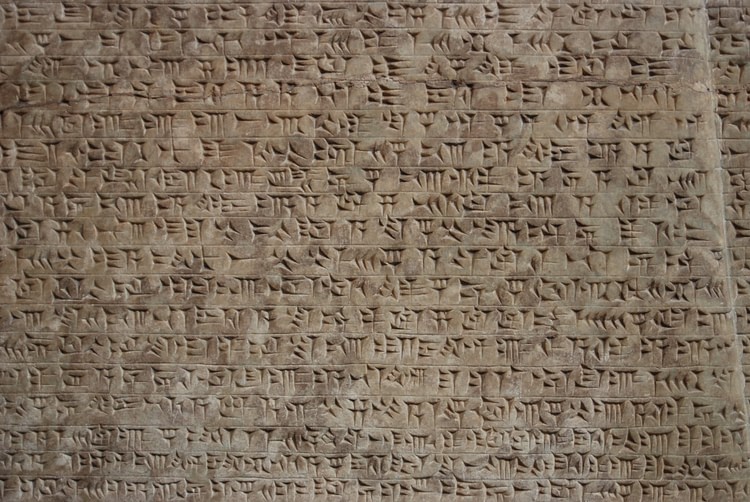
The Akkadian/Sumerian poet Enheduanna (2285-2250 BCE) is the world's first author known by name and was the daughter of Sargon of Akkad ( Sargon the Great, 2334-2279 BCE). Whether Enheduanna was, in fact, a blood relative of Sargon ’s or the title was figurative is not known. It is clear, however, that Sargon placed enormous trust in Enheduanna in elevating her to the position of high priestess of the most important temple in Sumer (in the city of Ur ) and leaving to her the responsibility for melding the Sumerian gods with the Akkadian ones to create the stability his empire needed to thrive.
Further, she is credited with creating the paradigms of poetry, psalms, and prayers used throughout the ancient world which led to the development of the genres recognized in the present day. Scholar Paul Kriwaczek writes:
Her compositions, though only rediscovered in modern times, remained models of petitionary prayer for [centuries]. Through the Babylonians, they influenced and inspired the prayers and psalms of the Hebrew Bibleand the Homeric hymns of Greece. Through them, faint echoes of Enheduanna, the first named literary author in history, can even be heard in the hymnody of the early Christian church. (121)
Her influence during her lifetime was as impressive as her literary legacy. Entrusted by her father with great responsibility, Enheduanna not only exceeded those expectations but changed the entire culture. Through her written works, she altered the very nature of the Mesopotamian gods and the perception the people had of the divine.
LIFE
Enheduanna's name translates as 'High Priestess of An' (the sky god) or 'En-Priestess, wife of the god Nanna '. She came from the northern city of Akkad and, as Kriwaczek notes, "would have had a Semitic birth name [but] on moving to Ur, the very heartland of Sumerian culture, she took a Sumerian official title: Enheduanna - `En' (Chief Priest or Priestess); `hedu' (ornament); `Ana' (of heaven)" (120). She organized and presided over the city's temple complex, the heart of the city, and held her own against an attempted coup by a Sumerian rebel named Lugal-Ane who forced her into exile. The Akkadian Empire, for all the wealth and stability it brought to the region, was constantly plagued by uprisings in the various regions under its control. One of Enheduanna's responsibilities in the region of Sumer would have been to keep the populace in check through religion.
HER HYMNS RE-DEFINED THE GODS FOR THE PEOPLE OF THE AKKADIAN EMPIRE UNDER SARGON'S RULE AND HELPED PROVIDE THE UNDERLYING RELIGIOUS HOMOGENIETY SOUGHT BY THE KING.
In the case of Lugal-Ane, however, she seems to have been bested, at least initially. In her writings, she tells the story of being driven from her post as high priestess and cast into exile. She writes a plea for help to the goddess Inanna requesting her to petition the god An for help:
Funeral offerings were brought, as if I had never lived there.I approached the light, but the light scorched me.I approached the shade, but I was covered with a storm.My honeyed mouth became scummed. Tell An about Lugal-Ane and my fate!May An undo it for me! As soon as you tell An about it, An will release me.
Inanna apparently heard her prayer and, through the gods intercession in her cause, she reports, Enheduanna was finally restored to her rightful place in the temple. She seems to have been the first woman to hold this position in Ur and her comportment as high priestess would have served as an exemplary model for those who followed her.
WORKS
She is best known for her works Inninsagurra, Ninmesarra, and Inninmehusa, which translate as 'The Great-Hearted Mistress', The Exaltation of Inanna', and 'Goddess of the Fearsome Powers', all three powerful hymns to the goddess Inanna (later identified with Ishtar and, still later, Aphrodite ). These hymns re-defined the gods for the people of the Akkadian Empire under Sargon's rule and helped provide the underlying religious homogeniety sought by the king. For over forty years Enheduanna held the office of high priestess, even surviving the attempted coup against her authority by Lugal-Ane.
In addition to her hymns, Enheduanna is remembered for the forty-two poems she wrote reflecting personal frustrations and hopes, religious devotion, her response to war, and feelings about the world she lived in. Her writing is very personal and direct and, as the historian Stephen Bertman notes:
The hymns provide us with the names of the major divinities the Mesopotamians worshipped and tell us where their chief temples were located [but] it is the prayers that teach us about humanity, for in prayers we encounter the hopes and fears of everyday mortal life. (172)
Enheduanna's prayers very clearly express those hopes and fears and do so in a very distinct voice. Paul Kriwaczek paints a picture of the poet at work:
Sitting in her chamber, or perhaps her office, for the director of an enterprise as large and prestigious as the Nanna temple of Ur must surely have been afforded the very best working arrangements, her hair beautifully coiffed by Ilum Palilis [her hairdresser] and staff, dictating to her scribe, perhaps the very Sagadu whose seal Wooley found, Enheduanna proceeded to make her permanent mark on history by composing, in her own name, a series of more than forty extraordinary liturgical works, which were copied and recopied for nearly 2,000 years. (121)
The skill and beauty of these works aside, their impact on Mesopotamian theology was profound. Enheduanna drew the gods closer to the people of the land, synthesizing Sumerian and Akkadian beliefs, to create a richer understanding than either had before. Her reflections on the moon god Nanna, for example, made him a deeper and more sympathetic character and she elevated Inanna from a local deity to the Queen of Heaven. These two deities, and the others she transformed through her work, appeared more compassionate than before; gods for all of the people and not only Sumerians or Akkadians.
DISCOVERY
In 1927, the British archaeologist Sir Leonard Woolley found the now-famous Enhuduanna calcite disc in his excavations at the Sumerian site of Ur. The three inscriptions on the disc identify the four figures depicted: Enheduanna, her Estate Manager Adda, her hair dresser Ilum Palilis, and her scribe Sagadu. The royal inscription on the disc, reads: "Enheduanna, zirru-priestess, wife of the god Nanna, daughter of Sargon, king of the world, in the temple of the goddess Innana.” The figure of Enheduanna is placed prominently on the disc emphasizing her importance in relation to the others and, further, her position of great power and influence on the culture of her time.
Wooley also uncovered the temple complex where the priestesses were buried in a special cemetery. Kriwaczek writes:
Records suggest that offerings continued to be made to these dead priestesses. That one of the most striking artefacts, physical proof of Enheduanna's existence, was found in a layer dateable to many centuries after her lifetime, makes it likely that she in particular was remembered and honoured long after the fall of the dynasty that had appointed her to the management of the temple. (120)
Further proof of her profound impact on culture is that she is still remembered and honoured in the present day and poems are still composed on the model she created over 4,000 years ago.
Enki › Who Was?
Definition and Origins
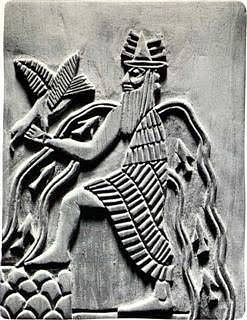
Enki (also known as Ea, Enkig, Nudimmud, Ninsiku) was the Sumerian god of wisdom, fresh water, intelligence, trickery and mischief, crafts, magic, exorcism, healing, creation, virility, fertility, and art. Iconography depicts him as a bearded man wearing a horned cap and long robes as he ascends the Mountain of the Sunrise; flowing streams of water run from his shoulders, emphasizing his association with life-giving water, while trees representing the male and female principle stand in the background. The streams are interpreted as the Tigris and Euphrates Rivers which, according to one myth, were formed from Enki's semen. His name means "Lord of the Earth" and his symbols are the fish and the goat, both representations of fertility.
Originally, Enki (then known as Enkig) was a Sumerian deity of fresh water and patron of the city of Eridu, considered by the Mesopotamians the first city established at the beginning of the world. The god first appears in the Early Dynastic Period IIIa (c. 2600-2350 BCE) and was established as an important god of the Akkadians by c. 2400 BCE who knew him as Ea.Excavations at Eridu, however, have uncovered evidence of a tradition of shrines to Enki dating back to the founding of the city c. 5400 BCE. At Eridu he was known as Enki and later, at Akkad, as Ea; the two names are used interchangably for the same deity as is the Babylonian name Nudimmud. Enki was known as Ninsiku only in his aspect as patron of crafts and art, especially objects devoted to divine subjects.
GENEALOGY & OFFSPRING
Enki was the son of Anu, the sky god, in Sumerian and Akkadian mythology and the son of Apsu, the primordial father, in Babylonian texts. He is also referred to as the son of the goddess Nammu, a primordial mother goddess who gave birth to the earth and heavens. Enki's wife was Ninhursag (also known, among many other names as Ninmah and, originally, as Damgalnuna, the Assyrian Damkina) and their sons were Asarluhi (god of magical knowledge), Enbilulu (god of canals and dikes), the human sage Adapa, and the king of the gods, Marduk (who would later absorb the qualities of Asarluhi). They also had eight children born of Ninhursag's efforts to heal Enki in the myth Enki and Ninhursag : Abu (god of plants and growth);Nintulla (Lord of Dilmun and precious metal); Ninsitu (goddess of healing, wife of healing-god Ninazu); Ninkasi (goddess of beer ); Nanshe (also Nanse, social justice, fertility, divination, and the interpretation of dreams); Azimua (goddess of healing, wife of underworld deity Ningishida); Emshag (Lord of Dilmun, god of fertility) and Ninti (goddess of the rib, giver of life). Enki is also often depicted as the father of one of the most popular and enduring deities, Inanna, goddess of war, sexuality, passion, fertility, love, and prostitutes. He had a twin brother, Adad (also known as Ishkur), god of weather and storms.
ALONG WITH ANU & ENLIL, ENKI MADE UP AN EARLY MESOPOTAMIAN TRIAD WHICH GOVERNED THE HIGH HEAVENS, ATMOSPHERE, & EARTH.
APPEARANCE IN LITERATURE
There are a number of Mesopotamian stories, legends, prayers and royal inscriptions in which Enki plays a major role. He is famously depicted in the works concerning Ninhursag (Ninmah) such as Enki and Ninhursag and Enki and Ninmah both of which concern the creation of the world and humanity. In the Enuma Elish, the Babylonian epic of creation, Enki is the father of the champion Marduk, who defeats the forces of chaos, and is co-creator of the world with his son. Enki also appears in the works The Atrahasis, The Marriage of Ereshkigal and Nergal, Inanna and The God of Wisdom, The Descent of Inanna, Enki and the World Order, Enmerkar and the Lord of Aratta, The Epic of Gilgamesh, and others. He was one of the most important deities in the Mesopotamian Pantheon along with Anu (Lord of Heaven), Enlil (Supreme Lord of Air), and Inanna.Along with Anu and Enlil, Enki made up an early Mesopotamian triad governing the high heavens, atmosphere, and earth. He is also listed among the earliest seven Sumerian deities in the god's list which also includes Anu, Enlil, Ninhursag, Utu, Nanna, and Inanna.
MYTHOLOGICAL ORIGIN FROM ENUMA ELISH
According to the Babylonian Enuma Elish (c. 1100 BCE), Enki was the oldest son of the first gods, Apsu and Tiamat. In the beginning of time, the world was undifferentiated swirling chaos from which separated Apsu, the male principle personified by fresh water and Tiamat, the female principle defined by salt water. Apsu and Tiamat gave birth to the younger gods but these deities had nothing to do and so amused themselves as best as they could. Their constant noise distracted Apsu and interrupted his sleep and so, after consulting with his vizier, he decided to kill them.
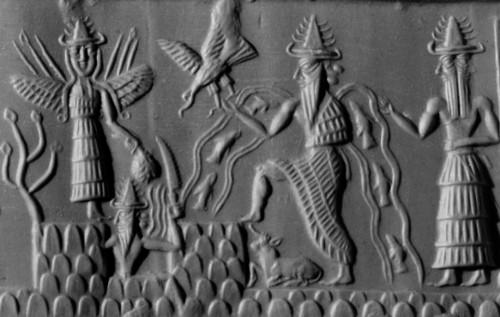
Enki on the Adda Seal
Tiamat overheard their discussion and was horrified by the plan and so whispered it to her son. Enki considered various plans and their consequences and then proceeded with the one he thought best: he put his father into a deep sleep and then killed him. Tiamat never considered such a possibility and disowned her children. She then raised an army of demons and monsters, led by her consort and champion Quingu (sometimes Kingu). This army of the older gods defeated Enki and the younger gods in battle each time they met until the younger group was driven back and began to lose hope.
At this point Enki's son Marduk stepped forth with an offer: if the gods would make him their king, he would lead them to victory. Prior to this, there had been no general overseeing the operations but each god took a turn at command. Once Marduk was elected king, he met Quingu in single combat and defeated him and then shot Tiamat with an arrow so great it split her in two. From her eyes ran the tears which would become the Tigris and Euphrates rivers and her body was used by Marduk to fashion the earth. Quingu, and other gods who had encouraged Tiamat's war, were executed and Quingu's body used to create human beings. Marduk consulted with Enki on all these choices and so Enki is often credited as co-creator of the world and life.
ENKI IN THE ATRAHASIS
The Akkadian/Babylonian story of The Atrahasis (c. 17th century BCE) gives another version of the creation but, still, Enki plays a pivotal role. In this story, the elder gods live a life of leisure and pleasure while making the younger gods do all the work in maintaining creation. The younger gods have no time to rest because there is always so much to do and so Enki proposes that they create lesser beings who will be co-workers with them. They have no idea what to make these new creatures out of until one of the gods, We-llu (also llawela), volunteers himself as a sacrifice and is killed. His flesh, blood, and intelligence are kneaded into clay by the mother goddess Ninhursag from which she creates seven male and seven female human beings. These fourteen new creatures are exceptionally fertile and soon there are hundreds, and then thousands, of people on the earth all doing the work which once occupied the younger gods.
At first, these people are exactly what the gods had hoped for but, as they grow in number, they become louder and more and more of a problem. Their constant noise and difficulties disturb the sleep of Enlil, king of the gods, and distract him from both his daily tasks and his leisure so he decides to cut down the population through a series of plagues. He sends a drought, then pestilence, then famine and, each time, the people appeal to their father-god Enki, the one who first conceived of them, and he helps them by telling them what they should do to return the earth to balance and productivity and their communities to full health.

Map of Sumer
Enlil is frustrated as now there seem to be even more people than when he first tried to get rid of them. He convinces the other gods to allow him to unleash a great flood which will destroy humanity and he is powerful enough to get them all to agree. Enki recognizes the cruelty and injustice of this plan but cannot deter Enlil so he goes to earth and finds an honest man, Atrahasis, one who has always been both wise and kind and has devoted himself to Enki piously. Enki whispers to him to build an ark and enter it with two of every kind of animal.
Atrahasis completes his mission just as the flood begins. The people cry out for help from the gods but no help is offered.Ninhursag weeps for the people and is inconsolable and the other gods also mourn but no one can stop the flood. Enlil recognizes that this flood may not have been the best idea but it is too late now; everyone on earth is dead. The flood waters subside, the ark comes to rest, and Enki whispers to Atrahasis that the time has come for him to open the ship and make sacrifices to the gods. Atrahasis does so and the sweet smell of his sacrifice floats up to heaven from which Enlil looks down to see someone has survived. He instantly knows Enki is behind this and, even though he was only just regretting what he had done, he focuses all his fury on him.
WHEN GIVEN A CHOICE BETWEEN SERVING THE WILL OF THE GODS OR THE NEEDS OF THE PEOPLE, ENKI ALWAYS CHOSE HUMAN INTERESTS & ALWAYS THE PATH OF COMPASSION, FORGIVENESS, & WISDOM.
Enki explains himself, however, and shows how good and kind a man Atrahasis is and directs them all to the sweet sacrifice.The gods are pleased and descend to earth to eat the sacrifice and then Enki proposes a new plan: the gods will create beings who are less fertile: infants will be carried away by demons, women will suffer miscarriages or be infertile, other women will be consecrated to the gods and remain perpetual virgins. Further, humans will not be given very long life spans and, in the time they do live, there will be opportunities daily for their death from many different causes. The gods agree to this proposal;Atrahasis, the last of his kind, is spirited away to the lands of the blessed and Ninhursag creates the new creatures.
ENKI AS TRICKSTER GOD
In both of these stories, Enki acts in the best interest of the community even if that community cannot appreciate it. In the Enuma Elish he defies his mother's hopes in killing Apsu but must do so for the greater good and, in The Atrahasis, he saves one good man to inspire Enlil to give humanity a second chance to live. In most of the other stories he is shown in this same way. In The Marriage of Ereshkigal and Nergal, for example, he arranges events so that Nergal, god of war, will be held in the underworld for six months out of the year, thus preventing warfare and strife during that time.
In The Descent of Inanna he contrives for his daughter's rescue from the underworld after she is killed by her sister Ereshkigal by sending two clever demons to trick the Queen of the Dead into giving them Inanna's corpse. He is shown in the story Inanna and the God of Wisdom as possessor of the meh, the laws and powers concerned with all of life and the gifts of civilization - the possessions of the gods alone - which he allows Inanna to take from him during a drunken party. Although he sends various forces after her to re-capture the meh and return them to him, it seems Inanna gets away with her stolen treasures fairly easily. In this, Enki is seen as he is in other works concerning Inanna: as the father of a daughter who would do anything for her, even if it may not seem the wisest or even the fairest choice under the circumstances. In The Descent of Inanna, after all, Inanna causes her own problems and it is actually Ereshkigal who is wronged and should be aided. In helping Inanna, however, Enki restores balance to the world and, again, makes his choice based on the good of the many.When he allows Inanna to take the meh, he knows she will give the gifts of civilization to humanity just as he knows that the other gods expect him to keep them out of human hands.
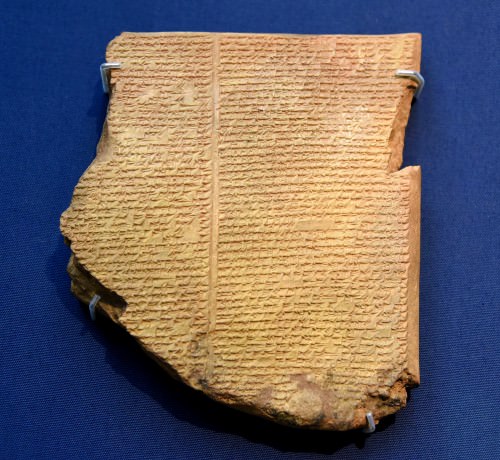
Flood Tablet of the Epic of Gilgamesh
As a trickster god, Enki reveals his wisdom - and so enlightens others - through actions which may not make sense on the surface. This is the case when he allows himself to get drunk and lets Inanna have the meh but also in The Epic of Gilgameshwhen he consents to the death of Enkidu, best friend of the hero Gilgamesh. Enkidu and Gilgamesh have just returned from another triumph when Inanna (known as Ishtar in the story) tries to seduce the hero and Gilgamesh, listing the many other lovers she has had who met with bad ends, refuses her. Inanna sends her sister Ereshkigal's husband, Gugulana (the bull of heaven) to destroy Gilgamesh's realm and Enkidu kills him. For raising his hand against a god, Enkidu must die. Enki consents to this - even though he recognizes Inanna caused the problem - because human beings must not think so highly of themselves that they will challenge the gods. More importantly, however, Enki realizes that Enkidu's death will introduce Gilgamesh to loss and this will lead him to an exploration of the meaning of life which will make him a deeper and more complete individual.
Even in Enki and Ninhursag, where he seduces his grown daughters because they remind him of his wife, Enki is portrayed sympathetically. He is punished for his transgressions which, it is made clear, he was guilty of only out of his great love for Ninhursag and a kind of enchantment he fell under because of missing her. His role as Trickster God is evident in this as his various mis-steps and sins result in the birth of deities favorable to humanity. This same is true in Enki and Ninmah in which Ninmah challenges him to a game while they are drinking beer and Enki manages to best her by creating a being she can do nothing to improve upon. His mischief in all these tales is evidence of his wisdom and his desire to do his best for humanity.
PATRON OF ERIDU & WORSHIP
Enki as patron of the city or Eridu is significant to his role as god of wisdom. Eridu was thought to be the first city created by the gods upon which order and law was conferred at the beginning of time and was later known as the "city of the first kings".Founded c. 5400 BCE, Eridu would remain an important religious center for thousands of years and serve in stories and legends about a "golden age" in the same way that later Hebrew writers would use a Garden of Eden.
Excavations at the city have uncovered shrines to Enki built and re-built at the same location over thousands of years. Even after the god was widely worshipped elsewhere, he continued to be associated with Eridu and the abzu (also absu ), the subterranean waters there. Enki was worshipped primarily at his temple known as E-abzu (House of the Abzu) and E-engur-ra (House of the Subterranean Waters). As with all other important Mesopotamian gods and goddesses, priests tended to the god's statue, temple, and temple complex which served the people in many different ways. The gods' temples were houses of healing, counseling centers, distribution centers, and holy sites. There were no temple services as one would recognize them in the present day and people mainly interacted with the gods during festivals, through communion with the lesser priests, or at home through private rituals.
At Eridu, Enki presided over the abzu but also over the mystical aspects of this primordial marsh from which the city - and life - was thought to have risen. Attended by his minister Isimud, Enki also had assorted creatures at his service such as giants, demons (both protective and destructive), and other mystical beings. Mermen and mermaids were thought to inhabit the watery depths of the abzu beneath the city while the Seven Sages (the abgal) lived with Enki in his palace. In every story or legend, Enki is associated with the heights and depths of universal understanding and is always seen as a friend of humanity.When given a choice between serving the will of the gods or the needs of the people, Enki always chose human interests and always the path of compassion, forgiveness, and wisdom.
Carthaginian Trade › Antique Origins
Ancient Civilizations
The Carthaginians, like their Phoenician forefathers, were highly successful traders who sailed the Mediterranean with their goods, and such was their success that Carthage became the richest city in the ancient world. Metals, foodstuffs, slaves, and high-quality manufactured goods such as fine cloths and gold jewellery were bought and sold to anyone who could afford them. The Carthaginians became renowned for their mercantile skills and ability to sell anything to anyone, but always at a price.
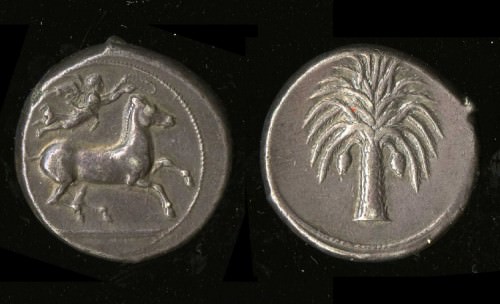
Carthaginian Silver Coin
THE EMPIRE & TRADING PARTNERS
From its founding in the late 9th century BCE by settlers from the Phoenician city of Tyre, Carthage almost immediately began to prosper thanks to its strategic location on the trade routes between the western Mediterranean and the Levant. Within a century the city would go on to found colonies of its own, and by the 6th century BCE it had taken over the mantle from Phoenicia as the region's greatest trading power. Carthage's commercial empire included North Africa, the Iberian Peninsula, Sicily, Sardinia, Corsica, Cyprus, Malta, and many other islands of the Mediterranean. Still not satisfied, expeditions were organised to find new and even more far-flung trade opportunities such as Himilco's voyage to Britain c. 450 BCE and Hanno's down the Atlantic coast of Africa c. 425 BCE.
The new territories would be a source of vast wealth, principally from natural resources such as gold and silver extracted from conquered regions. Just as the Europeans would exploit the natives of the ancient Americas in the 16th century CE, so too, the Carthaginians reaped rich rewards by transferring cheaply acquired metals to regions where they had a vastly higher value. In addition, these new territories, which later necessitated the foundation of colonies to protect trade interests and market monopolies, would eventually provide new markets to which the Carthaginians could export their own manufactured goods and those they acquired via trade from other cultures. Nor were the Carthaginians limited to sea routes as they are also known to have exploited the caravan routes of the Sahara.
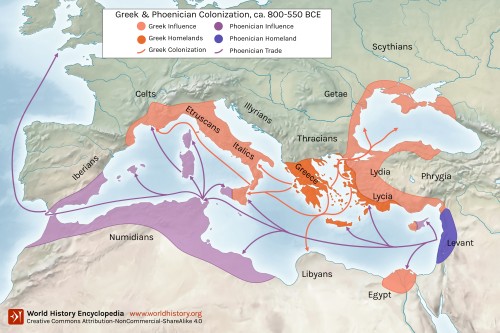
Greek and Phoenician Colonization
Herodotus, writing in the 5th century BCE, describes the method the Carthaginians used to barter with indigenous peoples in new territories along the North African coast, beyond the Pillars of Hercules :
The Carthaginians unload their wares and arrange them on the beach; then they re-board their boats and light a smoky fire. When the native inhabitants see the smoke, they come to the shore and, after setting out gold in exchange for the goods, they withdraw. The Carthaginians disembark and examine what the natives have left there, and if the gold appears to them a worthy price for their wares, they take it with them and depart; if not, they get back on their boats and sit down to wait while the natives approach again and set out more gold, until they satisfy the Carthaginians that the amount is sufficient. Neither side tries to wrong the other, for the Carthaginians do not touch the gold until it equals the value of their goods, nor do the natives touch the goods until the Carthaginians have taken away the gold. (Book IV, 196)
Carthaginian merchants, of course, also traded with contemporary powers in Greece, Egypt, Phoenicia, and the HellenisticKingdoms. Carthage signed treaties with other states to agree on areas of exclusive operation, notably with the Etruscansand with Rome c. 509 BCE and 348 BCE. Carthaginian traders were a common sight at the great markets of Athens, Delos, and Syracuse, sometimes having permanent quarters in the great cities of the day such as the Vicus Africus area of Rome.Punic amphorae have been discovered as far afield as Massilia (Marseille), Corsica, and Rome.
CARTHAGINIAN TRADERS WERE A COMMON SIGHT AT THE GREAT MARKETS OF ATHENS, DELOS, & SYRACUSE, SOMETIMES HAVING PERMANENT QUARTERS IN THE GREAT CITIES OF THE DAY.
Carthage also welcomed foreign traders in return who came from Rhodes, Athens, and Italy. They were treated equally with the city's own merchants, their goods were bought, stored, and re-exported by Carthaginian traders. Trade was further facilitated by the minting of coinage from the 5th century BCE and conversions were made easier when the Ptolemies of Egypt adopted the same Phoenician standard for their own coins. Carthaginian coins were made from gold, silver, electrum, and bronze.
The reputation of Carthaginian traders was well-known, if not particularly flattering, in the Greek world as attested by a star character in a lost Greek comedy play, re-worked by the Roman playwright Plautus in his Poenulus (The Punic Chappie). He describes one Hanno, a merchant, who has amongst his wares pipes, shoe-straps, and panthers, a comic cargo designed to show that the Carthaginians would trade in anything they could get their hands on as long as it turned a profit.
SEA TRADERS
Just how much trade was carried out by the state and which proportion by private merchants is unknown, but there is certainly evidence of both. It is likely that the bulk of trade was carried out by aristocratic merchants who also controlled the political and religious offices of Carthage. One important form of state intervention in the area of trade was the powerful Carthaginian naval fleet. This navy allowed Carthage to maintain its stranglehold on such key waystations along ancient shipping routes as Sicily and Gades ( Cadiz ) in southern Spain. It also ruthlessly dealt with the trading ships of competing powers. Any foreign ship discovered in waters considered by Carthage to be in its jurisdiction was sunk. Pirates were similarly dealt with.
Carthaginian trading ships were much like those long-used by Phoenician cities. Most common was the large hippos with a rounded bottom. The name (horse) derived from the horsehead which commonly appeared on the prow. A second type was the gaulos ('ship' in Phoenician) which was smaller and with an even wider hull.
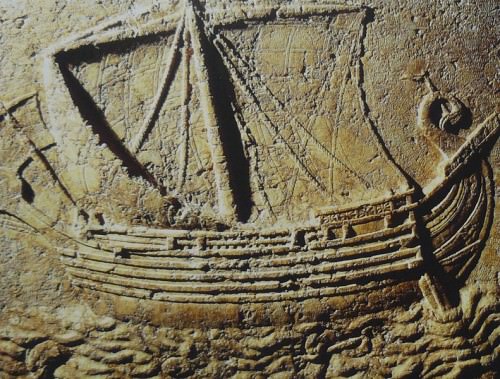
Phoenician Ship
Carthaginian ships and those of foreign merchants had at their disposal a large rectangular merchant harbour which connected to the city's circular naval harbour. Both ports were manmade, about two metres deep, and they possibly date to 220-210 BCE. This harbour replaced, or perhaps extended, the original simple key where merchant vessels had tied up in a row. The new merchant harbour measured 300 x 150 metres and was entered by a 250-metre arced channel. Iron chains could be raised to block this entrance if necessary.
TRADED GOODS
Raw materials, especially precious metals (gold, silver, tin, copper, lead, and iron), animal skins, wool, amber, ivory, and incense were imported and exported. Slaves were another valuable commodity that came and went through Carthage's port.Precious art objects made from gold, silver, and ivory were exported from Carthage's workshops. There were fine, embroidered textiles, including the fine carpets and cushions the Carthaginians were famous for, and the much sought-after purple-dyed cloth made using extract from the murex shellfish. Manufactured goods included weapons, food-related utensils, scissors, tools, bronze strigils (for cleaning the body after exercise), amulets, jewellery, decorative glassware, wooden furniture, ceramic figurines, decorated ostrich eggs, incense burners, and ornamental masks.
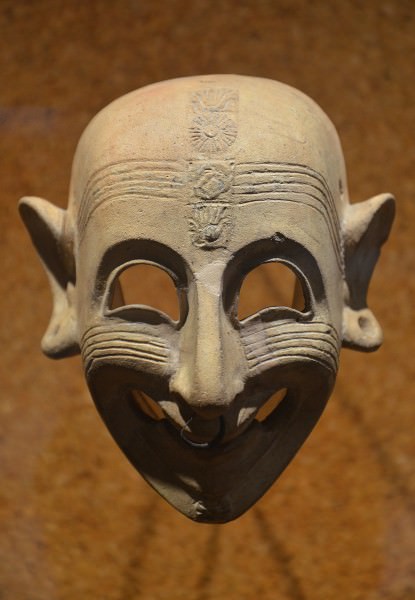
Phoenician-Punic Grinning Mask
Foodstuffs traded included olives, olive oil, wine, cereals, salted fish, garlic, pomegranates, nuts, herbs, and spices. Two Punic shipwrecks, one discovered off Ibiza (5th century BCE) and the other off Marsala on Sicily (3rd century BCE), both had cargoes of fish sauce, the garum which the Romans would become addicted to. The Marsala wreck also carried amphorae of wine and olives. Low-quality pottery vessels and lamps, affordable to the less rich tribes in such parts of the empire as Iberia, were first imported to Carthage from Corinth via Syracuse and central and southern Italy and then shipped for barter with local tribes.
CONCLUSION
Naturally, the Carthaginians did not have everything their own way and they faced competition for access to resource-rich territories and control of lucrative trade routes. This led to warfare in Sicily, especially against the tyrants of Syracuse, and with Rome, who turned out to be an enemy they could not match. After centuries of dominating the western Mediterranean the hugely expensive and debilitating Punic Wars would end in 146 BCE with Rome's destruction of Carthage. The city would rise again a century later and become an important trading and cultural centre within the Roman Empire, perhaps even amongst the top five cities therein, but it never quite reached the heights it had once achieved when Carthaginian ships had ruled the seas.
LICENSE:
Article based on information obtained from these sources:with permission from the Website Ancient History Encyclopedia
Content is available under License Creative Commons: Attribution-NonCommercial-ShareAlike 3.0 Unported. CC-BY-NC-SA License